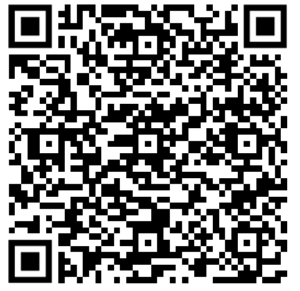
QR Code for the lesson and links below.
Unit Objectives:
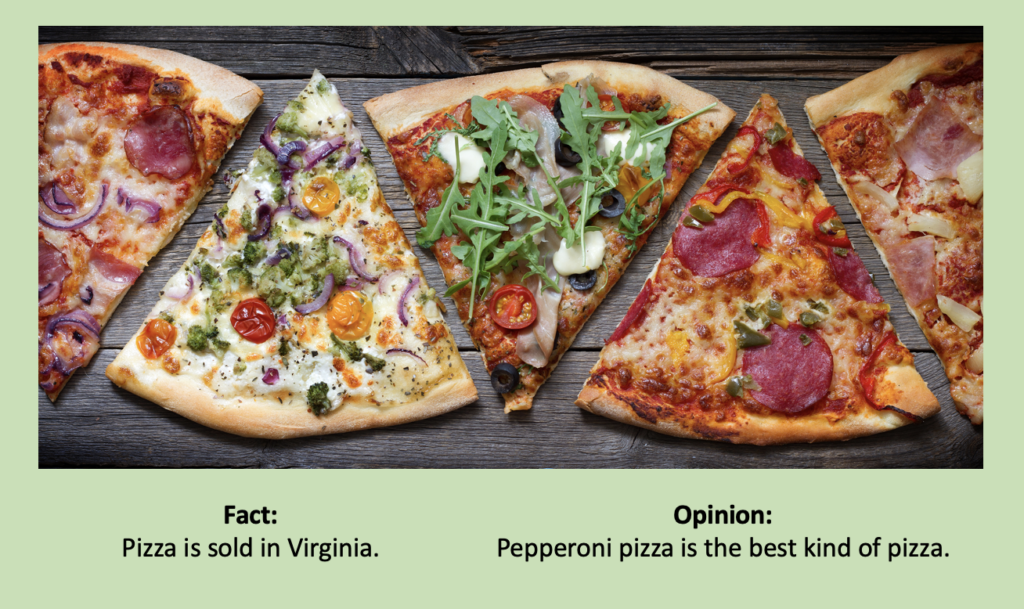
Learning Goal for 7th graders: “I can separate fact and opinion and recognize bias in media reporting and political campaign information.”
We use these questions to interrogate sources for potential bias:
- Who constructed and published the message? (source/author clearly presented?)
- What is the purpose of the message? (to sell? to encourage a particular voting behavior? to educate? entertain? If it’s an opinion piece or essay, is it clearly labeled as such?)
- Are the opinions and claims supported adequately by facts?
- Beware: Does it contain appeals to emotion (such as fear, anxiety, comfort, shock) in order to excite engagement (but possibly distract from thoughtful, deep analysis?)
We Explore…
Sixteen types of Media Bias: focus #2, #4, #9, #10, #11, #13 #14. Possibly apply NoodleTools as a skills follow up instead of an activity sheet. <– Maggie can easily monitor progress, evaluate there. Closing paragraphs of the long sheet concludes importantly! https://www.allsides.com/sites/default/files/16%20Types%20of%20Media%20Bias%20%20-%20AllSides2023.pdf
Media Bias Chart at https://www.allsides.com/blog/allsides-media-bias-chart-version-92-updated-ratings-plus-new-allsides-fact-check-bias-chart
Bottom line: Social Media is problematic if you seek balanced, objective news sources. Skilling yourself to detect bias and to consult news reporting that is curated by professionals helps citizens be open to perspectives instead of in an “echo chamber” that reinforces prejudice. Rather than depend on your pals/family or an Artificial Intelligence feed to send you news, it helps to apply curated and professionally researched news sources where the Journalist’s Code of Ethics was applied. You can use the library’s Research Guide for News.
Lesson Plan:
Display Essential Questions: How is fact distinguished from opinion in media? How can I detect biased or inaccurate media coverage of the news, or news that includes misinformation or disinformation? Who pays the cost if news is strongly biased or inaccurate or includes misinformation or disinformation? How can we select news sources with skill? How can I prevent the spread of misinformation?
Day 1: Students receive their white class notes. packet. Warm up Fact v. Opinion – note the pizza graphic and place statements in categories while working in pairs. Physical game – stand/sit to ID fact vs. opinion based chart here. Sit when you hear an opinion. What’s the difference between fact vs opinion? Pizza Handout notes: Facts are true for all people and proven by evidence. Opinions are neither true nor false… express belief, attitude, value, judgment or feeling. Opinions are debatable; one can agree or disagree with a statement of opinion.
Take this 2-question survey at
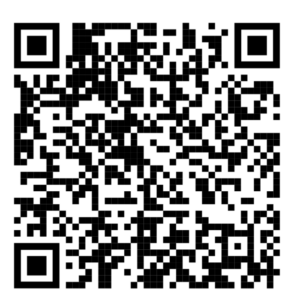
What might be the pro’s and con’s of various sources listed in our survey? Do some of the categories focus on more opinions than facts? Hmmmmm… Place in historical context.
BRIEF overview of media explosion since 1990’s to contextualize student info-whelm:
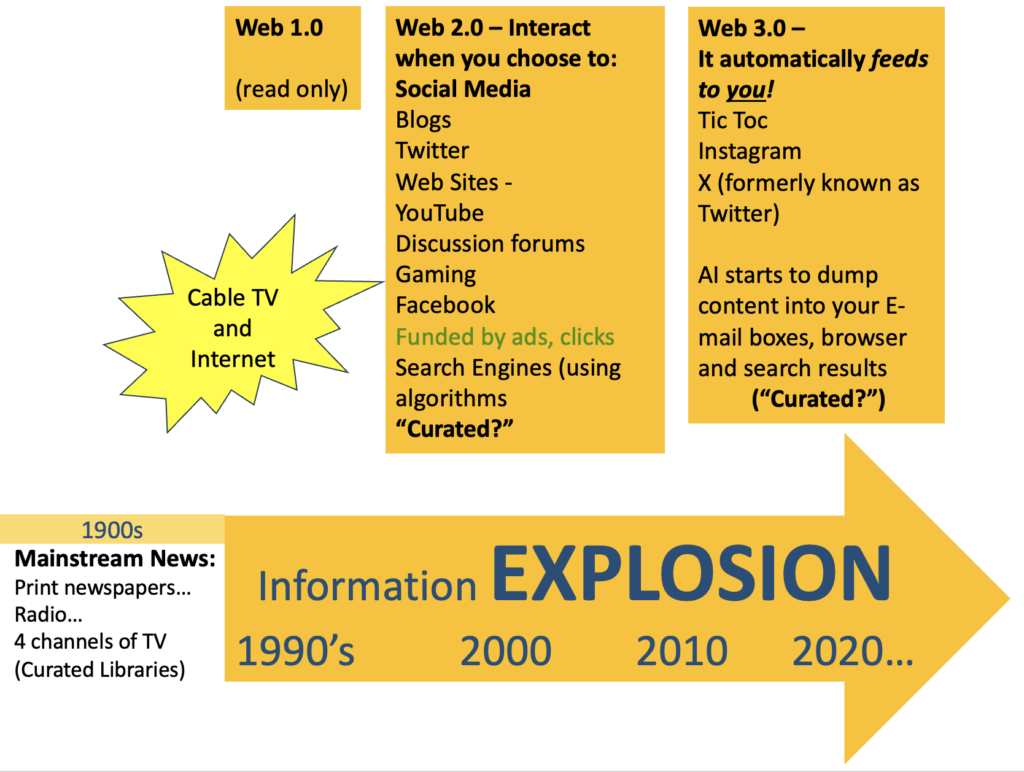
125-year evolution and EXPLOSION of Information Sources due to increasingly non-human, non-professional, non-curated platforms, having a vastly INCREASING immediacy and reach.
Exposure to a 20th and 21st century timeline of the evolution of media underscores the need for media literacy skills, especially by Americans who lead the world in education, media generation and international leadership / military might.
- Web 1.0 (the “read only” web, “TOP down” from professional content creators)
- Web 2.0 (begin to use social media for interactivity)
- Web 3.0 (“bottoms up” internet… mostly created and pushed around by EVERYONE)
- (Evolution of Web 1-3 detailed)
- commercial media – media produced/funded by advertising, subscription, or monetization of data that is collected through cookies, etc.
- algorithm (on the internet, it means a computer formula that search engines like Google use to identify “tagged content,” to collect and list results)
- AI = artificial intelligence
View BrainPop video “Media Literacy” and watch for media bias look fors, reinforcing the questions used to interrogate media for bias, purpose of media, how constructed with product placement, sensationalism. Link (requires logging into Clever.)
Students use these questions to interrogate media for potential bias:
- Who constructed and published the message? (source/author clearly presented?)
- What is the purpose of the message? (to sell? to encourage a particular voting behavior? to educate? entertain? If it’s an opinion piece or essay, is it clearly labeled as such?)
- Are the opinions and claims supported adequately by facts?
- Beware: Does it contain appeals to emotion (such as fear, anxiety, comfort, shock) in order to excite engagement (but possibly distract from thoughtful, deep analysis?)
Display or offer time for matching drill on handout to include a selction of this Academic Vocabulary is useful in this week’s work:
- fact vs opinion
- bias: a prejudice or leaning in favor of or against one thing, person, or group compared with another, usually in a way considered to be unfair
- liberal vs. conservative
- left wing vs. right wing
- partisan vs. nonpartisan vs. bi-partisan
- polarization: division into extreme left and extreme right leanings among citizenship. Polarization can lead to extremism. I may make compromise very difficult.
- journalism: the profession of writing for newspapers, magazines, or news websites or preparing news to be broadcast; professionally constructed news reporting
- media = content constructed and published for a purpose to broadly communicate a message. Examples: news, art, educational content, and any form of information that can reach or influence people, including television, radio, books, magazines, and the internet.
- professionally curated news (selected by a trained researcher, reviewed according to criteria rather than Artificial Intelligence, for example, )
- Journalist’s Code of Ethics. (Ethical means “doing the right thing” morally.)
- propaganda: media created (by a government or a political party) to gain power and possibly create division. It employs techniques to over-simplify issues, exaggerate, use fear-mongering, flattery, stereotypes, and shocking content as well as create heroes and villains. (Browse examples.)
News sources contain both facts and opinion. Notice in a Newspaper– Fact vs. Opinion/Editorial sections are clearly labeled. A description of events can appear factual to say what happened, but the way it is reported is subject to interpretation by a (biased?) reporter. The publisher may be motivated to increase readership through sensationalism or building a customer base. Over time, some professional news outlets get a reputation for being biased and holding onto readership of a particular party (perhaps by stirring OUTRAGE.)
Students compare two extremes on Trump Indictment: The Federalist vs CNBC
Social media contains both fact and opinion/ advocacy. Students Discuss: What are the issues with gathering your news through only social media?
- Is not professionally “curated.”
- It feeds to you based on your search terms, “likes,” searches and algorithms (no balance.)
- May produce “echo chambers”
- Allows misinformation that feeds conspiracy theories
- Repeated use of “fake news” label may lead to rejection of all news, even journalism which is balanced, skilled and ethically produced by experienced, skilled journalists following the Journalist’s Code of Ethics.
- So, always ask: what is the source and how did it arrive to you? What was the mission of the creator/ sender?
Challenge: in the coming week, if you see a piece of propaganda come at you from social media or broadcast media, try to identify which technique(s) below seem to be at work. Share it with Maggie in the Library. You can also browse THE WEEK’s political cartoons to explore application of the techniques below.
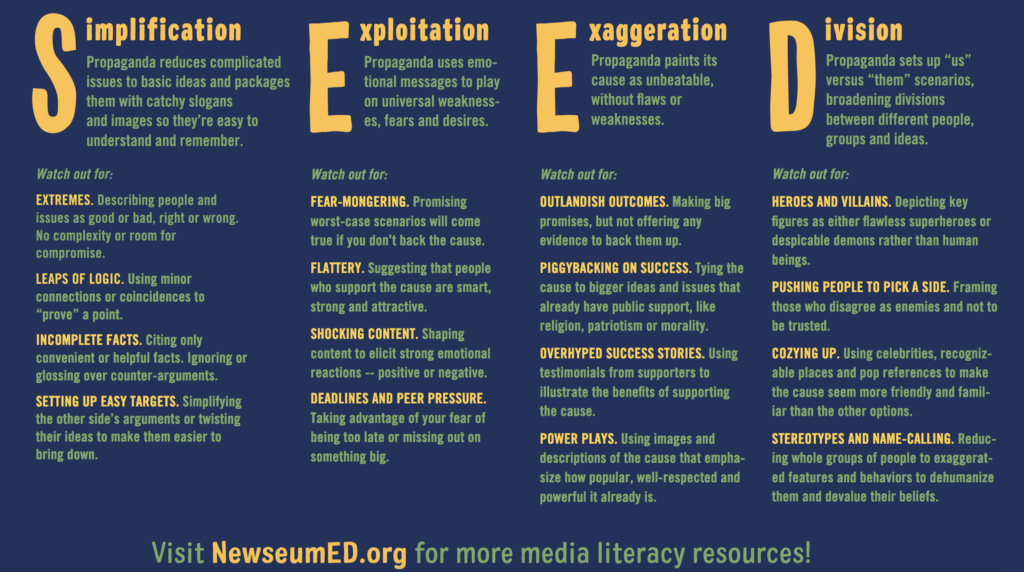
Closing: Teacher can review some of the terminology to be used tomorrow– matching game on a paper handout.
Day 2:
Warm-up: What percentage of your news comes from a professionally curated source vs. social media? Review survey results. Receive Library’s Yellow Packet.
“Biased” = slanted. Favoring one point of view over another. Demonstrating a prejudice in favor of or against one thing, person, or group compared with another, usually in a way considered to be unfair. Opposite of “objective / fair to both sides of an issue.”
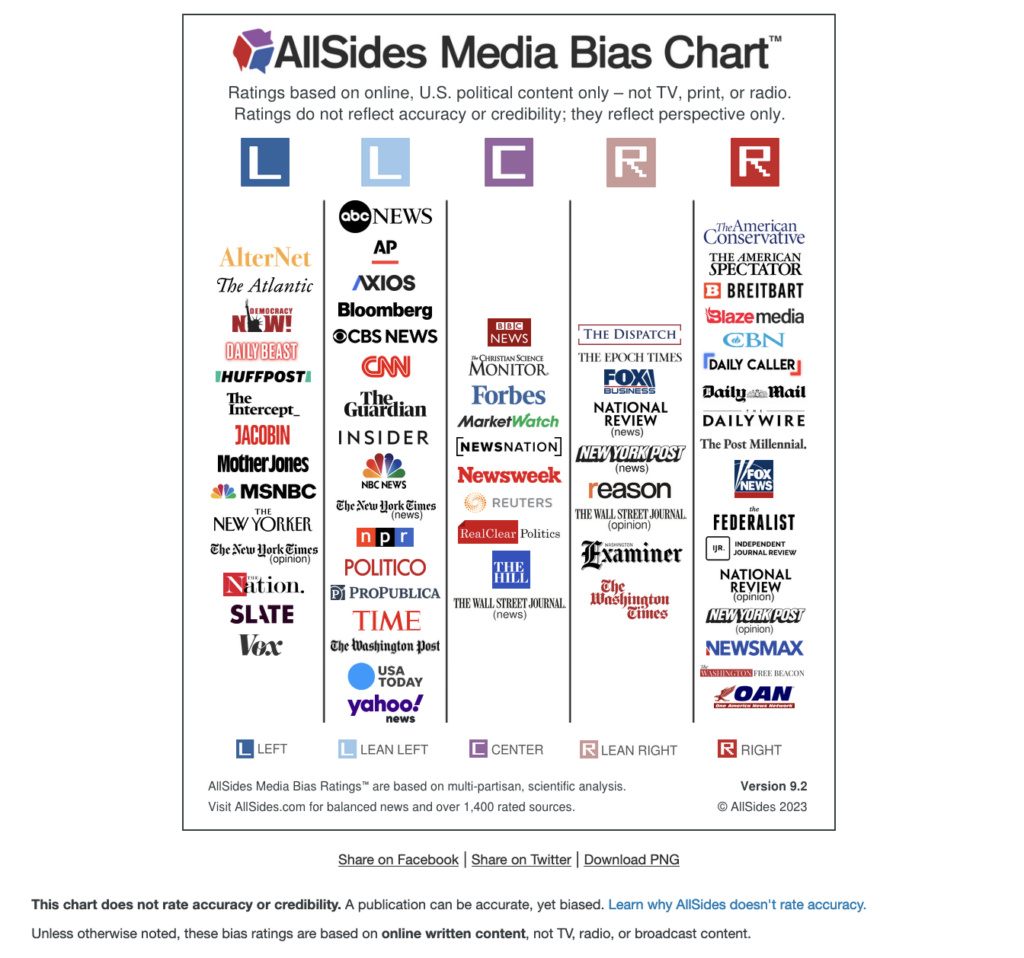
Source: https://www.allsides.com/media-bias/media-bias-chart
View media bias chart above. It’s a tool! Maggie explains: commercial media need for advertising dollars and clicks has nudged media to extremes, despite the Journalist’s Code of Ethics. Reflect on “editorial opinion.”
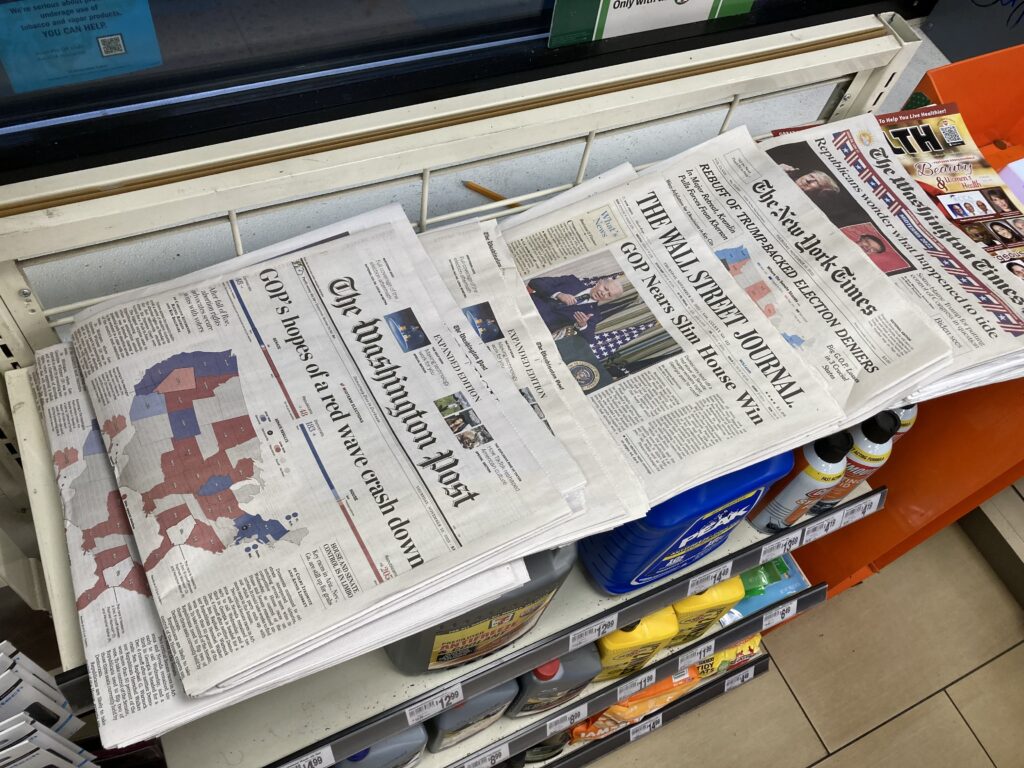
Election Day results headlines suggest the possible bias across newspapers. Photo by H-B student Isaac Studley.
Experience 7 of the 16 types of media bias summarized by AllSides:
How do we spot bias?
Maggie tag-teams with teacher to demonstrate scrolling through the media captured here by AllSides and below “thinking aloud, engaging students to react.” Employ placards to reinforce/scaffold vocab acquisition.
1) Unsubstantiated Claims AllSides p. 7 top and bottom) Anti-vax blog Post Notice Wikipedia about Jan 6th Trump Indictment (M fast)
2) Sensationalism – see headline of Fox Video and Slate and Roe v. Wade (C/N)
3) Bias by Omission – RT home page (Russia Today) Al Jazeera on I-H War (for a subtle statistical point where stats are taken out of context, see AllSides p. 18) (M)
4) Omission of Source Attribution (see AllSides p. 19) (C/N)
5) Bias by Story Choice and Placement RT home page (Russia Today) Today’s Washington Post vs. Florida Times Union Fox News web site Florida Daily (maybe see AllSides p. 21 and 22) (M)
6) Word Choice (see AllSides p. 25) Horribly Consequential Pelosi Breitbart on Gun Measure (C/N)
7) Photo Bias (see AllSides p. 26) and… Trump – how depicted? Roe v. Wade decision Breitbart on Gun Measure (M briefly… students dive in!)
Students interact On Photo Bias: Compare these examples of photo bias– the candidate’s own web page vs. the news reporting:
Donald Trump official web site Daily Mail photos of Trump and Hunter Biden
Nancy Pelosi official web site Mother Jones: Nancy Pelosi
Martha McSally her book-selling web site Last photo here of Martha McSally, Republican
Paired work by students – Open the links selected below; fill in your chart on your handout to score each for bias by using your Media Bias Chart and the definitions associated with each of the 7 “Look Fors.”
0 = unbiased (balanced) 5 = strongly biased:
Media 1 – NASA Astronaut Frank Rubio Accidentally Breaks The Record For Longest Time In Space
Media 2 – Adam Schiff
Media 3 – Gun Control Fast Facts – from NewsForKids
Media 4 – Roe v. Wade
Media 5 – Pro/Con on Gun Control – from Britannica
Media 6 – Portland protest
Media 7 – McCarthy Skips Pelosi
Media 8 – Forbes on how much time teens spend on screens (outside of homework time)
Media 9 – Gov. Glenn Youngkin’s government site (visit the “about” page)
Concluding the Lesson: Groups share out evaluations from above. Students read (aloud) concluding paragraph of All Sides handout.
Suggestions for class work or homework (Maggie can participate …in delivery and grading.)
1) Choose one of the above media sources or any other example of media in your social media feed (or find by searching on the web.)
2 ) Locate the NoodleTools project in your account to take the next step.
3) Use NoodleTools to build a citation, link the media source by its URL, and write a 4 sentence evaluation as an “annotation” in that NoodleTools Project.
4) Make sure you have “shared” your NoodleTools Project with Casey or Nora’s inbox so that Maggie, Casey and Nora can enjoy your resource evaluations for bias. Make sure you show off the vocabulary you have on our packet for this week.
5) Looking ahead: We will add more such media evaluations for bias this year and keep building that NoodleTools Project.
(How to login to NoodleTools.)
Or:
Research Projects often involve writing an Annotated Bibliography. Here’s instruction that H-B’s library can provide to Middle Schoolers.
Or: Discussion or extension with content below…
Fun Facts
…about Freedom of Speech/Press and why Citizens Care:
FF# 1) In a dictatorship where the government or political party in charge wants to stay in power, the government controls the media to make sure that it reports only information that favors the political party in charge. The media is “state controlled” (controlled by the government). The news will be biased in favor of the ruling party. In such situations, there is no freedom of the press to allow multiple opinions and ideas to surface. <–elaborate in terms of Putin in RT and the coverage of Ukraine. See the blue graphic above.
FF# 2) About X (formerly known as Twitter: ) Elon Musk is X’s new owner. He fights against laws asking him to filter the content of Twitter posts, even though the prior owners hired a huge team to label posts that contained disinformation or to remove Twitter accounts that spread them (like Donald Trump’s was removed.) Since Elon Musk took over ownership, many users have left that platform in protest.
Note: 2 Student Handouts were generated for this lesson to include:
Essential Questions above; QR Codes to this page and survey; Short Fact vs Opinion drill; Front loaded vocabulary in 2 matching drills; Liberal vs. Conservative chart; Timeline— to web 3.0; Questions to Interrogate a source; Academic Vocab to match; Definitions: Unsubstantiated Claims Sensationalism Bias by Omission Omission of Source Attribution Bias by Story Choice and Placement Word Choice Photo Bias; Concluding paragraph of All Sides article. Contact Maggie at margaret . carpenter @ apsva.us if you need a copy.
Resources for Advanced Students:
Article addresses threat of AI to increase disinformation, and detection tools from Washington Post.
Exposure to a 20th and 21st century timeline of the evolution of media is useful on these topics which can be the subject of further research.
- Web 1.0 (the “read only” web, “TOP down” from professional content creators)
- Web 2.0 (begin to use social media for interactivity)
- Web 3.0 (“bottoms up” internet… mostly created and pushed around by EVERYONE)
- (Evolution of Web 1-3 detailed)
- commercial media – media produced/funded by advertising, subscription, or monetization of data that is collected through cookies, etc.
- algorithm (on the internet, it means a computer formula that search engines like Google use to identify “tagged content,” to collect and list results)
- AI = artificial intelligence
-

125-year evolution and EXPLOSION of Information Sources due to increasingly non-human, non-professional, non-curated platforms, having a vastly INCREASING immediacy and reach.
More Resources on detecting bias:
Video: defines fact vs. opinion.
Forbes on how much time teens spend on screens (outside of homework time)
Note this lesson delivered to H-B’s 8th graders.
Consortium for Media Literacy: Good questions for framing approach if simplified: https://www.consortiumformedialiteracy.org/index.php?option=com_content&view=category&layout=blog&id=12&Itemid=24
Checkology – videos and activities used for evaluating sources – here. (Requires a teacher registration that is free; Maggie set it up as an “independent user” not an educator b/c of login glitches that the educator registration presented.) It has an interactive video presentation that addresses the term “Fake News” and then detailing how “misinformation” is accomplished for nepharious reasons. (Advanced.)
Newseum Activities and resources:1) Weeding out Propaganda – link — really great criteria worksheet to ID propaganda. Requires free account set-up; Maggie has login info to share if you need it. The image gallery is unavailable.
 Contact
Contact  Calendars
Calendars Careers
Careers Engage
Engage  District
District
